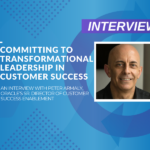It’s so consistently played out that we should start thinking of it as a law of the universe. Large organizations invariably face perpetual pressure to stay competitive against newer, smaller, more eager, and more nimble companies. You see it reported everyday in the business world and it’s the reason that Silicon Valley carries the mystique that it does. It’s where the world of tech startups still finds its center core, where VCs spend the most, and where groundbreaking research finds the most generous contributors. As an aside, that dynamic of smaller companies eating away at the business of larger companies is a major reason our economies evolve and expand over time. Competition fosters innovation which, in theory, benefits a host of people. And whether it’s true or not, those smaller companies portray themselves – through their nimbleness – as being more innovative and customer-centric and through those characteristics are able to attack chinks in the armor of larger companies. The secret defense that larger companies need to embrace and strengthen is to figure out how to improve the way they understand their customers’ businesses, their needs, and their experiences as they traverse their lifecycle with the company.
This is easier said than done.
One of the most significant challenges large companies struggle with when they want to understand the customer more holistically is the existence of organizational barriers. These are best thought of as ‘silos’ which are characterized by fragmented communication, unnecessary friction and ego, and slow bureaucratic processes that inhibit the free flow of valuable customer insights across departments. These barriers stifle innovation, slow down decision-making, and reduce an organization’s ability to respond effectively to customer needs. Artificial Intelligence (AI) – not just GenAI – offers a transformative opportunity to solve this problem. If leveraged properly, it can enable companies to break down these barriers and create a more integrated, agile, and customer-attentive environment.
The Challenge of Organizational Silos
Organizational silos have historically been natural byproducts as companies grew. Going all the way back to the days of Adam Smith’s Wealth of Nations and its central tenet about the division of labor, it’s how work could be best organized and managed to fit the constraints of time and human capabilities. But while it allows for tremendous speed and expansion of operations, operating in isolation, focusing solely on specific objectives without adequate communication or collaboration with other parts of the organization, can be – and usually is – stultifying for companies over time. This fragmented approach can lead to issues like:
- Inefficient Information Flow: Valuable customer insights gathered by one department, such as marketing or customer success, may not be shared effectively with other departments like product development or sales. This disconnect can result in missed opportunities to enhance products or tailor services to meet customer demands.
- Duplication of Efforts: When departments work in isolation, they may unknowingly duplicate efforts, wasting resources and time. For example, Marketing and product development teams often conduct separate customer research initiatives, resulting in redundant findings and inefficiencies. When the same customers are repeatedly consulted, it leads to significant frustration and dissatisfaction.
- Delayed Decision-Making: Silos can delay decision-making processes as departments independently gather and analyze customer data. This lag hinders an organization’s ability to quickly respond to market changes or customer behaviors and preferences.
- Inconsistent Customer Experience: When customer insights are not shared across the organization, it leads to an inconsistent customer experience. For example, the sales team might promise features unknown to the product team, creating downstream challenges for customer success. This misalignment results in customer dissatisfaction and potential churn.
How AI Breaks Down Barriers
AI has the potential to fundamentally change the way large organizations operate by breaking down these silos and fostering a more collaborative and customer-centric culture. Here’s how AI can help:
1. Unified Data Platforms
AI-powered platforms integrate data from various departments into a single, unified system. By processing and analyzing data from multiple sources—customer feedback, sales data, social media interactions—these platforms provide a comprehensive view of the customer journey. Centralizing this information ensures all departments access the same insights, fostering collaboration and reducing effort duplication.
For example, AI can automatically aggregate and analyze customer feedback from various channels—emails, social media, surveys—and present it in a dashboard accessible to all relevant teams. This shared resource allows marketing, sales, product development, and customer success teams to work from the same data set, ensuring consistency in decision-making and strategy development.
2. Advanced Analytics and Predictive Insights
AI excels at analyzing large datasets, identifying patterns not immediately apparent to human analysts. By applying machine learning algorithms to customer data, AI uncovers valuable insights, such as emerging customer preferences or potential product issues before they become widespread.
For instance, AI can analyze customer interactions to predict future behavior, such as the likelihood of a customer churning or purchasing additional products. These predictive insights can be shared across departments, allowing the company to take proactive steps—whether that’s improving a product feature, adjusting marketing strategies, or offering personalized incentives—to enhance the customer experience.
3. Automated Communication and Collaboration Tools
AI-driven communication tools automate sharing customer insights across departments. These tools can distribute reports, alerts, or updates based on predefined triggers or real-time data changes. For instance, if AI detects a spike in complaints about a product feature, it can notify both product development and customer success teams, enabling a coordinated response.
Furthermore, AI can facilitate collaboration by recommending relevant stakeholders or departments that should be involved in discussions based on the context of the data or insights. This proactive approach ensures that the right people are brought together to address issues or capitalize on opportunities, breaking down the traditional barriers of departmental isolation.
4. Enhanced Decision-Making Processes
AI enhances decision-making by providing real-time, data-driven insights accessible to all relevant stakeholders. This democratization of information ensures decisions are informed by a holistic view of customer needs and organizational goals, rather than being made in isolation.
For example, during product development, AI can provide real-time feedback on customer preferences, market trends, and competitor activity. This information can be shared with cross-functional teams, allowing them to make informed decisions that align with both customer demands and business objectives. Additionally, AI can simulate various scenarios, helping teams to anticipate the potential impact of their decisions and choose the best course of action.
5. Personalized Customer Engagement
AI enables companies to deliver personalized customer experiences at scale, a challenge for large organizations. By analyzing customer data, AI creates detailed profiles that include preferences, purchase history, and interaction patterns. These profiles help tailor marketing messages, product recommendations, and customer service interactions to individual needs.
For instance, AI can help the marketing team create personalized campaigns that resonate with specific customer segments, while simultaneously informing the product development team about features that are particularly appealing to certain demographics. It can also influence how marketing refines, and makes more precise, its messaging by factoring in the product experiences of existing customers, information that is often walled off in the customer success team’s information stores. This level of personalization ensures that the entire organization is aligned in delivering a cohesive and relevant customer experience.
The Cultural Shift: From Siloed to Collaborative
While AI provides the tools to break down organizational barriers, it necessitates a cultural shift within the company. Leaders must recognize AI’s critical role in the company’s success and foster a culture of collaboration, transparency, and continuous learning to fully realize its benefits. This cultural shift involves:
- Encouraging Cross-Departmental Collaboration: Organizations must promote collaboration between departments, encouraging teams to share insights, ideas, and strategies. This can be facilitated through regular cross-functional meetings, shared goals, and incentives that reward collaborative efforts.
- Emphasizing Data-Driven Decision-Making: Leaders should encourage a data-driven mindset across the organization, where decisions are based on insights derived from AI analytics rather than intuition or siloed information. Training programs and workshops can help employees at all levels become comfortable with AI tools and data interpretation.
- Investing in AI Talent and Infrastructure: To effectively leverage AI, organizations need to invest in the necessary talent and infrastructure. This includes hiring data scientists, AI specialists, and investing in AI platforms that integrate seamlessly with existing systems.
- Championing a Customer-Centric Approach: At the heart of breaking down organizational barriers is the need to keep the customer at the center of all decisions. AI can help by providing the tools to understand customer needs more deeply, but it requires a commitment from leadership to prioritize customer insights in strategic planning and execution.
AI is a Catalyst for Long Overdue Change to Business
I’m not a soothsayer, although I have in the past tried to cast myself that way to my gullible nieces and nephews. But one doesn’t have to possess special advanced predictive skills to recognize the power of Artificial Intelligence. It’s not just a technological advancement; it is a tool that can serve as a catalyst for organizational transformation. By breaking down barriers that inhibit the flow of customer insights, AI enables large companies to operate more efficiently, innovate more rapidly, and, most importantly, deliver a superior customer experience. However, to fully realize these benefits, companies must embrace both the technological and cultural changes that AI brings. By doing so, they can create an integrated, agile, and customer-centric organization ready to thrive in the competitive landscape of the future.






